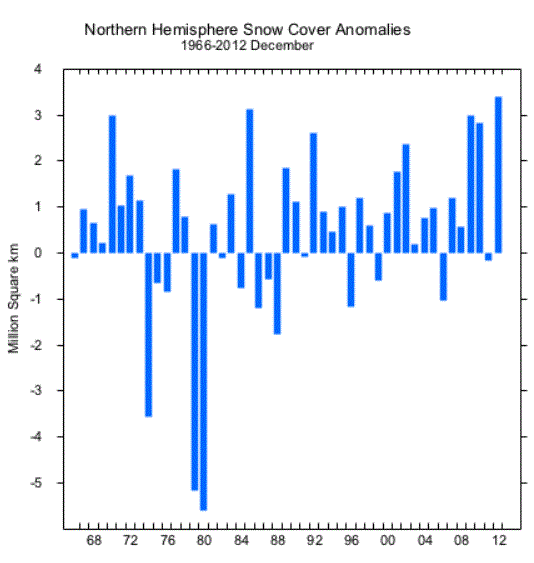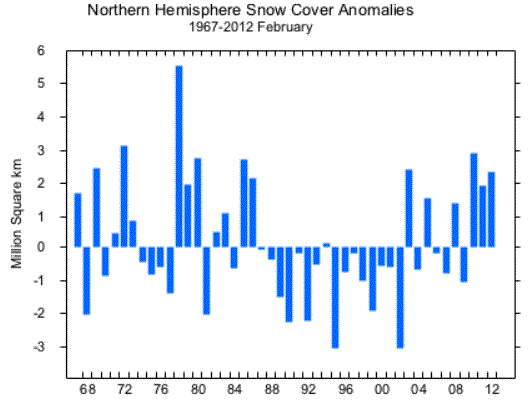Earlier today a reader (I think Juraj) left a comment with a link to a snow cover chart that disappeared on me. Sorry about the accidental deletion, but I’ve managed to find the chart using Google. According to Rutgers University here, snow cover over the northern hemisphere reached record December levels last month, thus dumping cold water on the notion that wintertime snows are getting rarer.
December northern hemisphere snow cover. Chart source:Rutgers University
Why is it that whenever snow disappears in the Arctic in the late summer, warmists scream bloody climate murder, but when snow reaches record levels in the wintertime, then they get real real quiet. Yoo-hoo media…where are you?
It would be nice to see a trend line on these charts. Actually I just found a time series here.
Looking at the last 30 years, we see a definite trend upwards. If this keeps up, all that albedo is going to reflect all the solar radiation back into space, and thus cool the Earth more, which will then lead to more snow cover, more albedo…and thus (assuming the warmists are right about the theory of melting Arctic sea ice), lead to a tipping of the climate.
The chart for January northern hemisphere snow cover also shows a clear upward trend over the last 20 years:
January northern hemisphere snow cover. Chart source: Rutgers University
As does the following February chart, which looks awfully cyclic:
February northern hemisphere snow cover. Chart source:Rutgers University
Finally, We can’t really expect northern hemisphere snow to disappear anytime soon in the weeks ahead. Joe Bastardi tweeted that the Arctic Oscillation is in a nosedive.








[…] Northern Hemisphere Snow Cover Sets All Time December Record – 9 Million Sq Km More Than 32 Years … Share this:EmailPrintTwitterDiggFacebookStumbleUponRedditLike this:LikeBe the first to like this. […]
Looks like each season, or even month, runs its own cycle. Winters are snowier, springs and summers are less snowy up north. There is definitely some kind of feedback, but also regular cycles in air circulation; CET winters mimic the AO cuylce, while CET summers follow the AMO cycle.
We are currently having our third snowfall since Christmas Eve. The temperature this morning was 24 F, (~-4.5 C). The only thing unusual is that it isn’t melting or evaporating between snowfalls.
I live east of the Cascade Mtns. in Washington State. Beginning in early October we got 3 snowfalls of about 4 inches (10 cm.) each. They each melted before the next arrived. Then we got a couple that did not melt but did settle quite a bit. The last one, before Christmas, was very fluffy and has stayed that way. We have had high pressure with stratus or fog and almost no wind.
Interesting that the biggest reduction of snow cover occurred just after the so called Great Climate Shift of the late 70s:
http://www.appinsys.com/GlobalWarming/The1976-78ClimateShift.htm
It seems that although warming of the atmosphere continued until the late 90s the amount of snow has since been recovering.
And we all know that the sun became less active from the late 90s don’t we ?
And that since 2000 the jet stream tracks have been more meridional ?
Despite increasing human CO2 emissions which therefore may well be irrelevant ?
Happy New Year.
Help! Being a biologist, I know zero about the AO and AMO, and precious little about ENSO. The comment regarding Joe Bastardi clearly implies that a nosediving AO will have significant consequences (temperature drop? How much? How long? etc)
Is there a short, concise review I can access to bring me up to speed?
Many thanks!
And, to one and all, Happy New Year!
A concise review? Not exactly. Try this:
http://bobtisdale.wordpress.com/2012/09/03/everything-you-every-wanted-to-know-about-el-nino-and-la-nina-2/
You can also search** places such as WUWT but you have to wade through many un-helpful comments to find the few that correct or help in understanding the article. Keep following links.
**Search on WUWT is a tiny slot on the right side below a changing ad.
Oh. Joe B. often mis-characterizes the PDO as like the AMO. When you get to the point when you understand the issue – you will be up to speed.
Here is a link to the Daily Snow map from Rutgers. It omits snow-on-ice so it ought to mention “land” in the title.
http://climate.rutgers.edu/snowcover/chart_daily.php?ui_year=2013&ui_day=3&ui_set=0
There is one issue with the extreme low snow cover in spring/summer; since the land disappears the more to the north we move, it gives distorted view. Pity we do not have such data for full AMO cycle.
[…] record was 9 million square kilometers more than 32 years ago. (But don’t tell the liberal […]
[…] record was 9 million square kilometers more than 32 years ago. (But don’t tell the liberal […]
So what?
The melting point of ice is 32F. Whether the ambient temperature is 24F or 26F, snow does not melt. Hence, additional atmospheric water vapor from the increased mean global temperature results in the slight increase noted in winter snow extent. But as the spring thaw begins earlier and extends more northward, we see significantly reduced snow extent in spring. Overall, there has been a decrease in snow extent. Also note that snow extent does not represent snow volume.
When discussing the effects of snow cover on albedo why ignore the more significant spring data from the Rutgers website?
The earth continues to warm.
So you’re saying snow area expands when the temperature goes from 32°F to 34°F?
“Hence, additional atmospheric water vapor from the increased mean global temperature results in the slight increase noted in winter snow extent. But as the spring thaw begins earlier and extends more northward, we see significantly reduced snow extent in spring. ”
When the water vapor condenses and falls as snow as you say it is no more available to enhance CO2’s greenhouse effect.
You have just dismissed the IPCC’s science which bases its projections of future warming on an increase in water vapor. When the water vapor condenses it’s gone.
Please explain. You’re not against the IPCC or are you?
[…] record was 9 million square kilometers more than 32 years ago. (But don’t tell the liberal […]
I am agnostic concerning the IPCC.
Are you seriously suggesting that local snowfall decreases the overall water vapor content of the atmosphere? Or are you trying to change the subject?
The author of this piece is trying to mislead his readers. If the author had bothered to examine all the information at the Rutgers site instead of picking just a small piece that supports his bias he would have seen that overall, snow extent is decreasing. Click on the above supplied ‘time series’ link to Rutgers and examine the data yourselves. Look at the very first graph, a composite of ALL the collected data from 1966 until now. The overall trend shows a DECREASE in snow extent. Look at the graphs for the spring months. If you pick ONLY the March graphs over the past 40 years you would conclude that snow cover has decreased. But picking only the March data would be misleading.
Here’s a reasonable conclusion based on all the data: Since the 1960s, the year to year snow extent appears to be increasing each winter but appears to be decreasing even more each spring.
We might expect a reasonable person to ask ‘Why?’, rather than try to hide the decline in spring snow extent. (See how I was able to work ‘hide the decline’ in there??).
This writer directly relates winter (in particular December) snow cover with earth albedo and global warming, even to declaring that snow cover will stop global warming in the future. First, December snow cover means little to radiating light back to space because there is minimal to almost no daylight in the snow covered parts of the northern hemisphere. Same goes for January.
Also, snow cover is only slightly important, it is snow depth since as soon as the weather warms thin snow cover disappears quickly.
After having checked the EPA Climate Change Indicators page and looked at the seasonal breakdown for snow cover in the northern hemisphere, the fall, summer and spring all have decreased since 1970 (the most important times since the sun actually has an effect). The summer snow cover has fallen by more than 50%, that would be arctic and high altitude cover. One would expect the arctic to be the primary indicator since they receive more sunlight than anywhere else in the late spring -early summer season and it will be the first to go.
Add the loss of ice cover in the Arctic warm season and albedo really has dropped out.
So to summarize, this article confuses weather and climate, chooses the wrong season to use albedo for radiative forcing and shows a lack of understanding seasonal solar insolation variation. These factors lead to an erroneous conclusion about snow cover effects on climate change.
Yawn